中西方教育差异英文
- 格式:ppt
- 大小:2.02 MB
- 文档页数:12

中西方教育差异英语作文英文回答:Throughout my academic journey, I have had the privilege of experiencing both Eastern and Western educational systems, and the disparities between them have been both striking and instructive.In the West, education is often characterized by an emphasis on critical thinking, independent learning, and student-centered instruction. Students are encouraged to question authority, express their own ideas, and engage in active learning through hands-on activities, discussions, and presentations. The aim is to foster intellectual curiosity, analytical skills, and a thirst for knowledge that extends beyond the classroom.For instance, in my Western history class, we delved into the complexities of the American Civil War through primary source documents, lively debates, and thought-provoking essays. This approach forced me to critically evaluate different historical perspectives, form my own opinions, and effectively communicate my findings.By contrast, Eastern education places a greater emphasis on rote learning, memorization, and respect for authority. Students are expected to diligently absorb vast quantities of knowledge, often through lectures and textbooks, and demonstrate their comprehension through exams and assignments that test their ability to recall and regurgitate information.I recall vividly sitting in an Eastern geography class, diligently taking notes as the teacher meticulously presented the capitals and major cities of every country in the world. While this method undoubtedly helped me retain a wealth of geographical facts, it left little room for critical analysis or the development of my own unique perspectives.Another key difference lies in the relationship between teachers and students. In the West, teachers are oftenviewed as facilitators who guide and encourage students' learning. They foster an open and collaborative classroom environment where students feel comfortable asking questions, expressing their thoughts, and working together.In my Western literature class, for instance, our professor facilitated lively discussions on the works of Shakespeare, in which we debated interpretations, analyzed literary devices, and shared our insights with one another. This open dialogue not only deepened my understanding of the texts but also fostered a sense of camaraderie among the students.In Eastern cultures, on the other hand, teachers are often seen as authoritative figures who command respect and obedience. Students are expected to listen attentively, take copious notes, and avoid challenging the teacher's knowledge or expertise.I once had an Eastern math teacher who demanded unwavering silence and attention throughout his lectures. Any attempt to ask a question or clarify a concept was metwith a stern rebuke. This stifled my curiosity and made me hesitant to engage with the material.Moreover, the educational environments in which these different approaches are implemented vary significantly. Western schools often prioritize modern facilities, state-of-the-art technology, and well-resourced libraries. This provides students with ample opportunities to explore their interests, conduct research, and collaborate with their peers.In my Western university, for instance, I had access to a vast online database, a fully equipped science lab, and an abundance of study spaces and social areas. This supportive environment allowed me to immerse myself in my studies and connect with other students from diverse backgrounds.Eastern schools, on the other hand, may often lack the same level of material resources. Students may have to rely on outdated textbooks, limited access to technology, and crowded classrooms. This can pose challenges for studentswho seek to engage in hands-on learning or pursue interests that require specialized equipment.In my Eastern high school, for instance, the science lab was poorly equipped, and experiments were often conducted with inadequate materials. This limited myability to fully grasp scientific concepts and conduct meaningful investigations.These are but a few of the many differences between Eastern and Western education. As a student who has navigated both systems, I appreciate the strengths and limitations of each approach. While Western education fosters critical thinking, independent learning, and a passion for knowledge, Eastern education instills discipline, respect for authority, and a deep knowledge base.Ultimately, the best educational approach for an individual student depends on their unique learning style, aspirations, and cultural context. By understanding the different educational philosophies and methodologies,students can make informed decisions about their own educational journey and pursue the learning experiences that will best equip them for success in life.中文回答:中西方教育差异。
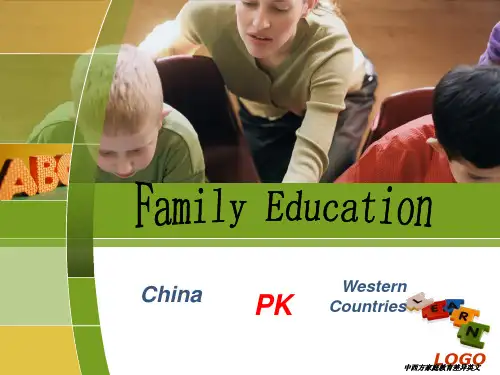
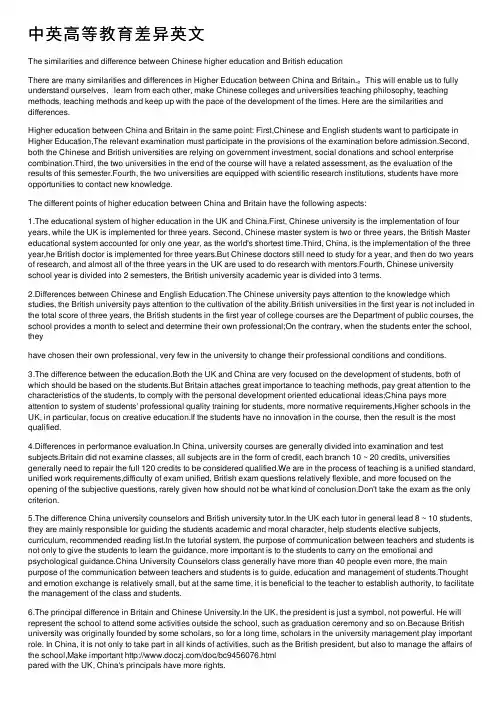
中英⾼等教育差异英⽂The similarities and difference between Chinese higher education and British educationThere are many similarities and differences in Higher Education between China and Britain.。
This will enable us to fully understand ourselves,learn from each other, make Chinese colleges and universities teaching philosophy, teaching methods, teaching methods and keep up with the pace of the development of the times. Here are the similarities and differences.Higher education between China and Britain in the same point: First,Chinese and English students want to participate in Higher Education,The relevant examination must participate in the provisions of the examination before admission.Second, both the Chinese and British universities are relying on government investment, social donations and school enterprise combination.Third, the two universities in the end of the course will have a related assessment, as the evaluation of the results of this semester.Fourth, the two universities are equipped with scientific research institutions, students have more opportunities to contact new knowledge.The different points of higher education between China and Britain have the following aspects:1.The educational system of higher education in the UK and China.First, Chinese university is the implementation of four years, while the UK is implemented for three years. Second, Chinese master system is two or three years, the British Master educational system accounted for only one year, as the world's shortest time.Third, China, is the implementation of the three year,he British doctor is implemented for three years.But Chinese doctors still need to study for a year, and then do two years of research, and almost all of the three years in the UK are used to do research with mentors.Fourth, Chinese university school year is divided into 2 semesters, the British university academic year is divided into 3 terms.2.Differences between Chinese and English Education.The Chinese university pays attention to the knowledge which studies, the British university pays attention to the cultivation of the ability.British universities in the first year is not included in the total score of three years, the British students in the first year of college courses are the Department of public courses, the school provides a month to select and determine their own professional;On the contrary, when the students enter the school, theyhave chosen their own professional, very few in the university to change their professional conditions and conditions.3.The difference between the education.Both the UK and China are very focused on the development of students, both of which should be based on the students.But Britain attaches great importance to teaching methods, pay great attention to the characteristics of the students, to comply with the personal development oriented educational ideas;China pays more attention to system of students' professional quality training for students, more normative requirements,Higher schools in the UK, in particular, focus on creative education.If the students have no innovation in the course, then the result is the most qualified.4.Differences in performance evaluation.In China, university courses are generally divided into examination and test subjects.Britain did not examine classes, all subjects are in the form of credit, each branch 10 ~ 20 credits, universities generally need to repair the full 120 credits to be considered qualified.We are in the process of teaching is a unified standard, unified work requirements,difficulty of exam unified, British exam questions relatively flexible, and more focused on the opening of the subjective questions, rarely given how should not be what kind of conclusion.Don't take the exam as the only criterion.5.The difference China university counselors and British university tutor.In the UK each tutor in general lead 8 ~ 10 students, they are mainly responsible for guiding the students academic and moral character, help students elective subjects, curriculum, recommended reading list.In the tutorial system, the purpose of communication between teachers and students is not only to give the students to learn the guidance, more important is to the students to carry on the emotional and psychological guidance.China University Counselors class generally have more than 40 people even more, the main purpose of the communication between teachers and students is to guide, education and management of students.Thought and emotion exchange is relatively small, but at the same time, it is beneficial to the teacher to establish authority, to facilitate the management of the class and students.6.The principal difference in Britain and Chinese University.In the UK, the president is just a symbol, not powerful. He will represent the school to attend some activities outside the school, such as graduation ceremony and so on.Because British university was originally founded by some scholars, so for a long time, scholars in the university management play important role. In China, it is not only to take part in all kinds of activities, such as the British president, but also to manage the affairs of the school,Make important /doc/bc9456076.htmlpared with the UK, China's principals have more rights.Hope that the Chinese universities can fully study the British universities a bit, and constantly develop themselves, improve their education level.1.顾明远⽐较教育研究(2006(2006年第9期)北京师范⼤学出版社2.朱晓芳2012年底17期企业导报3.湖南省教育厅主编<⾼等教育学> 湖南⼤学出版社4.王保星《西⽅教育⼗⼆讲》⼴西师范⼤学出版社5.孙⽴军.《英国⾼校学⽣事务⼯作的基本情况及启⽰》思想政治教育研究。
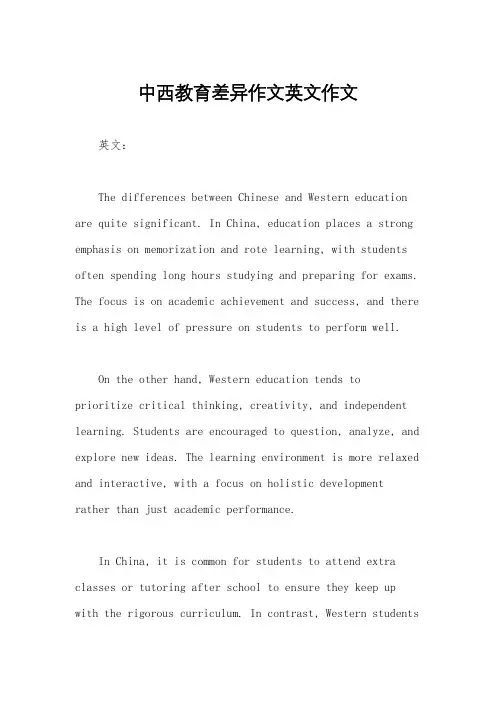
中西教育差异作文英文作文英文:The differences between Chinese and Western education are quite significant. In China, education places a strong emphasis on memorization and rote learning, with students often spending long hours studying and preparing for exams. The focus is on academic achievement and success, and there is a high level of pressure on students to perform well.On the other hand, Western education tends toprioritize critical thinking, creativity, and independent learning. Students are encouraged to question, analyze, and explore new ideas. The learning environment is more relaxed and interactive, with a focus on holistic developmentrather than just academic performance.In China, it is common for students to attend extra classes or tutoring after school to ensure they keep up with the rigorous curriculum. In contrast, Western studentsoften have more free time to pursue extracurricular activities and hobbies, which can contribute to their overall personal growth and development.One example of the differences in education is the approach to problem-solving. In China, students are often taught to solve problems using established methods and formulas, whereas in the West, they are encouraged to think outside the box and come up with innovative solutions.Overall, both Chinese and Western education systems have their strengths and weaknesses, and there is much to be learned from each other's approaches.中文:中西教育的差异是非常显著的。
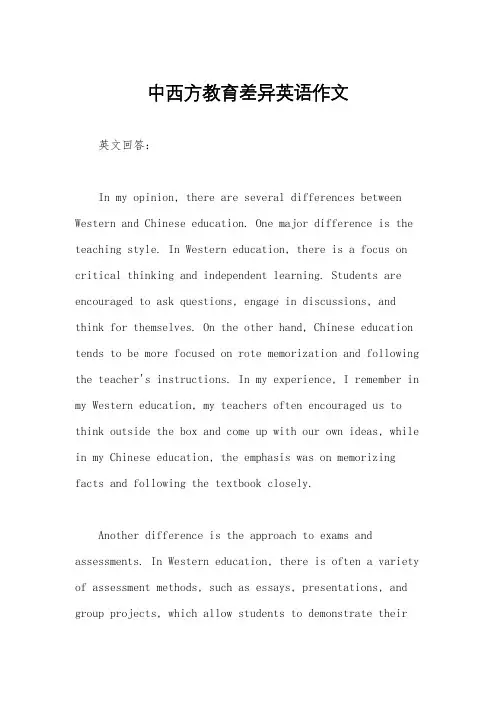
中西方教育差异英语作文英文回答:In my opinion, there are several differences between Western and Chinese education. One major difference is the teaching style. In Western education, there is a focus on critical thinking and independent learning. Students are encouraged to ask questions, engage in discussions, and think for themselves. On the other hand, Chinese education tends to be more focused on rote memorization and following the teacher's instructions. In my experience, I remember in my Western education, my teachers often encouraged us to think outside the box and come up with our own ideas, while in my Chinese education, the emphasis was on memorizing facts and following the textbook closely.Another difference is the approach to exams and assessments. In Western education, there is often a variety of assessment methods, such as essays, presentations, and group projects, which allow students to demonstrate theirunderstanding in different ways. In Chinese education, exams are the primary form of assessment, and there is a heavy emphasis on scoring well on standardized tests. For example, when I was studying in the West, I had the opportunity to do a group project where we had to research and present our findings, which was a great opportunity to work with my peers and develop my communication skills. On the other hand, in my Chinese education, I had to take multiple choice exams that tested my ability to recall information.中文回答:在我看来,中西方教育有几个不同之处。
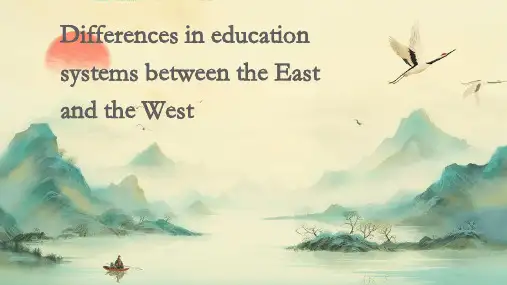
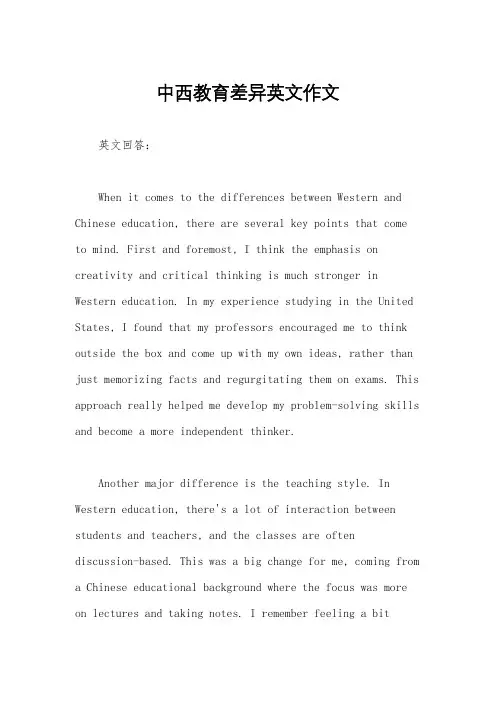
中西教育差异英文作文英文回答:When it comes to the differences between Western and Chinese education, there are several key points that come to mind. First and foremost, I think the emphasis on creativity and critical thinking is much stronger in Western education. In my experience studying in the United States, I found that my professors encouraged me to think outside the box and come up with my own ideas, rather than just memorizing facts and regurgitating them on exams. This approach really helped me develop my problem-solving skills and become a more independent thinker.Another major difference is the teaching style. In Western education, there's a lot of interaction between students and teachers, and the classes are oftendiscussion-based. This was a big change for me, coming from a Chinese educational background where the focus was more on lectures and taking notes. I remember feeling a bitoverwhelmed at first, but I quickly adapted to the more participatory style of learning.One aspect of Chinese education that I do appreciate is the emphasis on discipline and hard work. In Chinese schools, there's a strong focus on rote memorization and practice, which can be tough at times, but it definitely instills a strong work ethic. On the other hand, I think Western education places more emphasis on individuality and personal development, which I also find valuable.Overall, I believe that both Western and Chinese education have their strengths and weaknesses, and I feel fortunate to have experienced both. Each system has something unique to offer, and I think a combination of the two approaches could be really beneficial for students.中文回答:谈到中西教育的差异,我觉得有几个关键点值得一提。

中外教育差别英文作文英文:Education is an essential part of our lives, and it differs greatly between cultures. As someone who has experienced both Chinese and Western education systems, I can tell you that there are significant differences in the way they approach learning.Firstly, in Western education, there is a greater emphasis on critical thinking and creativity. Students are encouraged to question and challenge ideas, rather than simply memorizing information. This approach fosters independent thinking and problem-solving skills, which are highly valued in the workforce.On the other hand, Chinese education places more emphasis on rote learning and memorization. Students are expected to memorize vast amounts of information and regurgitate it on exams. While this approach may lead tohigh test scores, it can stifle creativity and critical thinking skills.Another key difference is the role of the teacher. In Western education, teachers act more as facilitators, guiding students in their learning and encouraging them to explore different ideas. In contrast, Chinese teachers are seen as authority figures, and students are expected to respect and obey them without question.Despite these differences, both systems have their strengths and weaknesses. For example, Western education may be better at fostering creativity and critical thinking, but it may not provide as strong a foundation in basic knowledge as Chinese education. Similarly, while Chinese education may produce high test scores, it may not prepare students as well for real-world problem-solving.Ultimately, the best education system is one that combines the strengths of both cultures. By incorporating critical thinking and creativity into Chinese education and emphasizing basic knowledge in Western education, we cancreate a more well-rounded and effective system.中文:教育是我们生活中不可或缺的一部分,而且在不同的文化中存在着很大的差异。
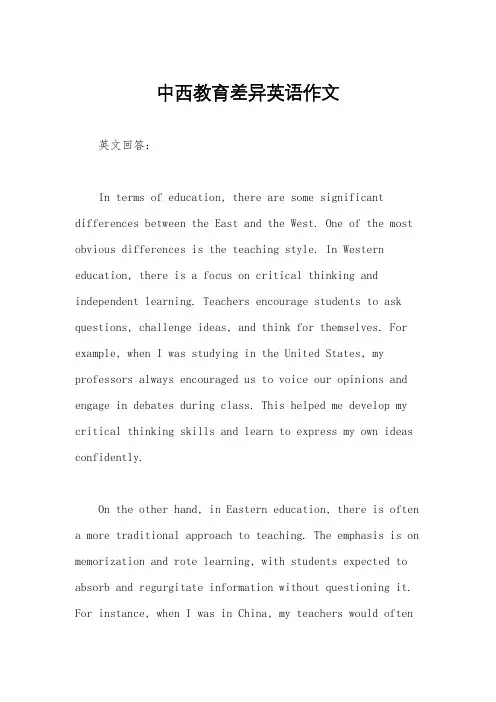
中西教育差异英语作文英文回答:In terms of education, there are some significant differences between the East and the West. One of the most obvious differences is the teaching style. In Western education, there is a focus on critical thinking and independent learning. Teachers encourage students to ask questions, challenge ideas, and think for themselves. For example, when I was studying in the United States, my professors always encouraged us to voice our opinions and engage in debates during class. This helped me develop my critical thinking skills and learn to express my own ideas confidently.On the other hand, in Eastern education, there is often a more traditional approach to teaching. The emphasis is on memorization and rote learning, with students expected to absorb and regurgitate information without questioning it. For instance, when I was in China, my teachers would oftenexpect us to memorize entire textbooks and recite them word for word during exams. This approach can be effective in helping students master a large amount of knowledge, but it may not necessarily foster independent thinking and creativity.Another difference is the attitude towards failure. In Western education, making mistakes is seen as a natural part of the learning process. Students are encouraged to take risks, try new things, and learn from their failures. For instance, when I made a mistake on a test in the UK, my teacher would sit down with me and help me understand where I went wrong, rather than just giving me a low grade and moving on. This helped me develop resilience and a growth mindset.In contrast, in Eastern education, there is often a strong aversion to failure. Students are under immense pressure to perform well academically, and failure is often stigmatized. For example, when I failed a math test in Japan, I felt a great deal of shame and embarrassment, and my classmates and teachers seemed to view me differently.This can create a fear of failure and a reluctance to take risks, which may hinder personal growth and development.中文回答:在教育方面,东西方之间存在一些显著的差异。
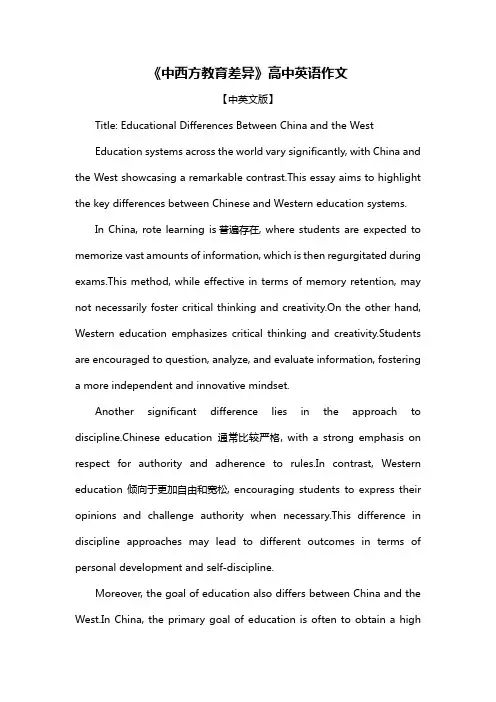
《中西方教育差异》高中英语作文【中英文版】Title: Educational Differences Between China and the WestEducation systems across the world vary significantly, with China and the West showcasing a remarkable contrast.This essay aims to highlight the key differences between Chinese and Western education systems.In China, rote learning is普遍存在, where students are expected to memorize vast amounts of information, which is then regurgitated during exams.This method, while effective in terms of memory retention, may not necessarily foster critical thinking and creativity.On the other hand, Western education emphasizes critical thinking and creativity.Students are encouraged to question, analyze, and evaluate information, fostering a more independent and innovative mindset.Another significant difference lies in the approach to discipline.Chinese education通常比较严格, with a strong emphasis on respect for authority and adherence to rules.In contrast, Western education倾向于更加自由和宽松, encouraging students to express their opinions and challenge authority when necessary.This difference in discipline approaches may lead to different outcomes in terms of personal development and self-discipline.Moreover, the goal of education also differs between China and the West.In China, the primary goal of education is often to obtain a highscore on the college entrance examination, which is seen as the gateway to a successful future.As a result, students often face immense pressure to excel academically.In contrast, Western education places more emphasis on overall development,包括社交技能、情感发展和创造力。
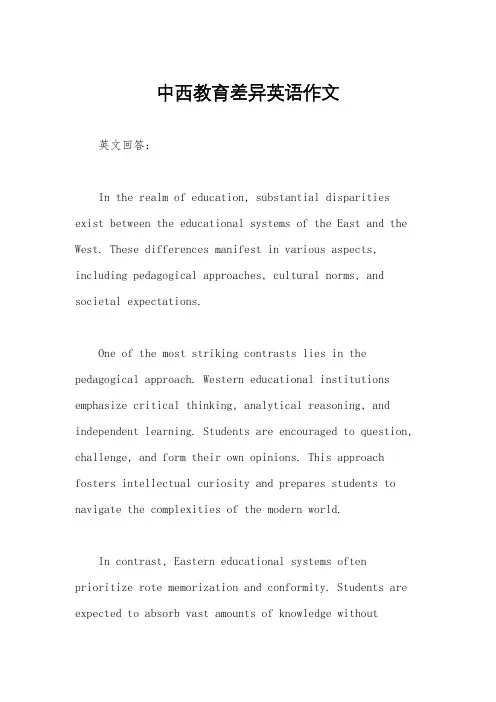
中西教育差异英语作文英文回答:In the realm of education, substantial disparities exist between the educational systems of the East and the West. These differences manifest in various aspects, including pedagogical approaches, cultural norms, and societal expectations.One of the most striking contrasts lies in the pedagogical approach. Western educational institutions emphasize critical thinking, analytical reasoning, and independent learning. Students are encouraged to question, challenge, and form their own opinions. This approach fosters intellectual curiosity and prepares students to navigate the complexities of the modern world.In contrast, Eastern educational systems often prioritize rote memorization and conformity. Students are expected to absorb vast amounts of knowledge withoutquestioning its veracity. This approach values obedienceand respect for authority, aiming to develop a stable and harmonious society.Cultural norms also play a significant role in shaping educational practices. In Western societies, individualismis highly valued. Students are encouraged to express their unique perspectives and pursue their passions. This fosters creativity, innovation, and a sense of personal accomplishment.In Eastern cultures, collectivism takes precedence. Students are taught to prioritize the interests of thegroup over their own. This emphasis on social harmony and cooperation promotes a sense of belonging and mutual support.Societal expectations also differ between the East and the West. In Western societies, education is seen as a means to achieve individual success and economic prosperity. Students are expected to excel academically and secure prestigious degrees. This pressure can lead to acompetitive and stressful learning environment.In Eastern societies, education is viewed as a lifelong journey of personal growth and self-improvement. Students are encouraged to cultivate virtues such as diligence, humility, and perseverance. This holistic approach emphasizes the development of a well-rounded individual who contributes to the well-being of society.To illustrate these differences, consider the teaching styles in math classrooms. In Western classrooms, teachers often employ interactive methods that encourage student participation and critical thinking. They pose open-ended questions, facilitate group discussions, and provide personalized feedback.In Eastern classrooms, teachers typically focus on delivering content through lectures and note-taking. Students are expected to memorize formulas and algorithms without much room for questioning or exploration. This approach emphasizes efficiency and standardization.Another key difference lies in the assessment methods. Western educational systems rely heavily on standardized testing to evaluate student performance. These tests measure cognitive abilities and academic knowledge. This approach emphasizes objective measurement and accountability.Eastern educational systems, on the other hand, often utilize a more holistic approach to assessment. Students are evaluated not only on their academic performance but also on their character, effort, and contributions to the class. This approach fosters a sense of community and encourages all students to participate.In conclusion, the educational systems of the East and the West exhibit fundamental differences in their pedagogical approaches, cultural norms, and societal expectations. These disparities reflect the unique values and priorities of each society and influence the way students learn, think, and develop.中文回答:中西方教育差异显而易见,体现在教学方法、文化理念和社会期待等多个方面。
中西教育体系差异英文作文英文:In terms of the differences between the Chinese and Western education systems, there are quite a few key points to consider. First and foremost, the Chinese education system is known for its emphasis on rote memorization and standardized testing. Students in China are often required to memorize large amounts of information and regurgitate it on exams, which can be quite stressful and doesn't necessarily promote critical thinking or creativity. On the other hand, the Western education system, particularly in countries like the United States, places a greater emphasis on critical thinking, creativity, and problem-solving skills. Students are encouraged to think outside the box and to express their own opinions and ideas.Another major difference is the structure of the school day. In China, students typically have long school days and heavy workloads, often spending most of their time in theclassroom. In contrast, Western schools often have shorter school days and more emphasis on extracurricular activities and hands-on learning experiences. For example, in the US, it's common for students to participate in sports, music, art, and other activities outside of their regular academic classes.In terms of teaching methods, Chinese classrooms tend to be more teacher-centered, with the teacher as the authority figure and the primary source of information. In Western classrooms, there is often more interaction between students and teachers, and a greater emphasis on student-centered learning. This means that students are encouraged to take an active role in their own education and to participate in discussions and group activities.Furthermore, the content of the curriculum also differs between the two systems. Chinese students often focus on core subjects such as math, science, and language, with less emphasis on subjects like art, music, and physical education. In the US, there is a greater emphasis on awell-rounded education, with students being exposed to awider range of subjects and having the opportunity to explore their interests and talents.Overall, while both the Chinese and Western education systems have their strengths and weaknesses, it's clearthat they have different approaches to teaching and learning. It's important to recognize and understand these differences in order to appreciate the diversity of educational practices around the world.中文:就中国和西方教育体系之间的差异而言,有一些关键点需要考虑。
中西方教育差异英语作文英文回答:In terms of education, there are definitely some differences between the East and the West. One of the main differences is the teaching style. In the West, the teaching style is often more interactive and student-centered. Teachers encourage students to ask questions and engage in discussions, and there is a focus on critical thinking and problem-solving skills. On the other hand, in the East, the teaching style is often more traditional and teacher-centered. Students are expected to listen to the teacher and memorize information, and there is less emphasis on critical thinking and more emphasis on rote learning.Another difference is the attitude towards failure. In the West, failure is often seen as a natural part of the learning process and is not stigmatized. Students are encouraged to take risks and learn from their mistakes. Inthe East, however, there is often a strong aversion to failure, and students may feel a lot of pressure to succeed. This can lead to a fear of taking risks and a reluctance to try new things.Furthermore, the subjects taught in schools can also differ between the East and the West. In the West, there is often a greater emphasis on the arts and humanities, and students are encouraged to explore their creativity. In the East, there is often a greater emphasis on subjects like math and science, and there is a focus on academic achievement.中文回答:在教育方面,东西方之间确实存在一些差异。
A part of western education emphasizes the teaching of students' independent thinking and the way of expressing themselves. Many factual information is found in the book, so the teacher focuses on how to help the students interpret the content in a more meaningful way. As the Greek philosopher Socrates, American teachers and students will continue to ask questions to force you to state your view, and others openly share. Based on these differences, Chinese students to the United States at the beginning of the school will have a great impact, see the American students to ask questions or answer, and even to the challenge of the professor, will feel uncomfortable, think these students how to be so arrogant and disrespect, students should absolutely comply with the authority of the professor is. Moreover, my English is so poor, why should I make a fool? With the Americans and other countries' friends. Participate in the school club, sports organizations, students will, and so can promote social life. In the local community, you can join a number of service organizations and volunteer organizations, the reception family, etc.. Although there are academic pressures, but a lot of benefits to participate in extra-curricular activities, but also the way to lift the pressure.The creative thinking in the process of American school more attention to practice and practice. This is an important distinction between domestic education and Western education. Domestic students tend to have amazing memory capability and good mathematical foundation, which is Chinese students to achieve success in the exam oriented education, but higher education in the United States more require students to participation, practice and creation, many courses are arranged a case study and the discussion of time and students of case analysis and statements with students as the center of teaching activities. The teacher to the students face a very short time, about students with learning time is about 30%. The rest of the time depends on the students themselves, the library access to information, the students to discuss each other, to learn to understand the relevant knowledge. In the process of participation and practice, students self-learning and their ability to solve the problem has been improved. Because they change from passive learning to active learning attitude, learning effect is different, there are different.American education is the combination of the universal and the elite education, you can let the students choose to be when civilians or do the elite". Own choose "elite" road and need to work hard and struggle, to choice of civilian road walk, accepts the popularization education, flat faint, madding crowd to accept society needed to survive the basic knowledge education. This is why a lot of knowledge teaching. Only to a point. Such education is the education of the mass of the populace. Chinese students have no choice in this form of society, the United States is different, choose the "elite" of the road, a few people, as long as the hard work, serious study, and strive to "essence" "deep", also can realize their "elite" education.西方教育的一部份强调的是教导学生独立思考及各种自我表达的方式。